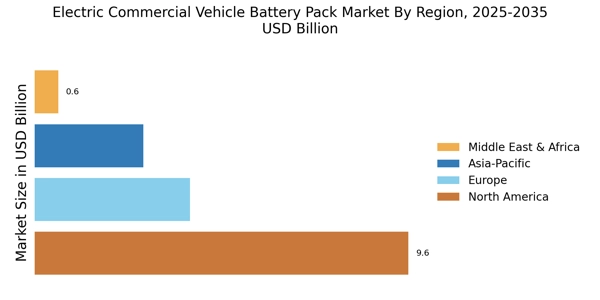Government Incentives and Support
Government incentives and support play a crucial role in driving the Electric Commercial Vehicle Battery Pack Market. Various governments are implementing policies aimed at promoting electric vehicle adoption, including tax credits, grants, and subsidies for both manufacturers and consumers. These initiatives are designed to lower the total cost of ownership for electric commercial vehicles, making them more attractive to businesses. In 2025, many regions are expected to enhance their support for electric vehicle infrastructure, which will further stimulate the demand for battery packs. The financial backing from governments not only encourages manufacturers to innovate but also fosters a competitive market environment, thereby accelerating advancements in battery technology within the Electric Commercial Vehicle Battery Pack Market.
Technological Innovations in Battery Design
Technological innovations in battery design are significantly influencing the Electric Commercial Vehicle Battery Pack Market. Recent advancements in lithium-ion and solid-state battery technologies are enhancing energy density, safety, and longevity. In 2025, the introduction of new materials and manufacturing processes is expected to reduce costs and improve performance metrics for battery packs. For instance, the development of lighter and more efficient battery systems can lead to increased payload capacities for electric commercial vehicles. This trend not only meets the growing demands of fleet operators but also aligns with the broader goals of reducing carbon emissions. As a result, the Electric Commercial Vehicle Battery Pack Market is likely to witness a surge in investment aimed at research and development of next-generation battery technologies.
Expansion of Logistics and Delivery Services
The expansion of logistics and delivery services is a significant driver for the Electric Commercial Vehicle Battery Pack Market. With the rise of e-commerce and the need for efficient last-mile delivery solutions, companies are increasingly turning to electric commercial vehicles. In 2025, the logistics sector is projected to adopt electric vehicles at an accelerated pace, driven by the need for cost-effective and environmentally friendly transportation options. This shift not only reduces operational costs but also addresses urban air quality concerns. Consequently, the demand for high-performance battery packs that can support the operational requirements of these vehicles is expected to rise, thereby propelling the Electric Commercial Vehicle Battery Pack Market forward. The integration of electric vehicles into logistics networks is likely to redefine industry standards.
Increased Focus on Environmental Regulations
An increased focus on environmental regulations is shaping the Electric Commercial Vehicle Battery Pack Market. As governments worldwide implement stricter emissions standards, businesses are compelled to transition to electric commercial vehicles to comply with these regulations. In 2025, the regulatory landscape is expected to become even more stringent, pushing companies to adopt cleaner technologies. This regulatory pressure not only drives the demand for electric vehicles but also necessitates the development of efficient battery packs that can meet the performance and safety standards set forth by regulatory bodies. The Electric Commercial Vehicle Battery Pack Market is thus positioned to benefit from this trend, as manufacturers innovate to create solutions that align with environmental goals and regulatory requirements.
Rising Demand for Electric Commercial Vehicles
The increasing demand for electric commercial vehicles is a primary driver for the Electric Commercial Vehicle Battery Pack Market. As businesses seek to reduce operational costs and enhance sustainability, the shift towards electric vehicles is becoming more pronounced. In 2025, it is estimated that the market for electric commercial vehicles will grow significantly, with projections indicating a compound annual growth rate of over 20%. This surge in demand necessitates the development of advanced battery packs that can support longer ranges and faster charging times, thereby propelling the Electric Commercial Vehicle Battery Pack Market forward. Furthermore, the transition to electric vehicles aligns with corporate sustainability goals, making it a strategic imperative for many companies.


















Leave a Comment